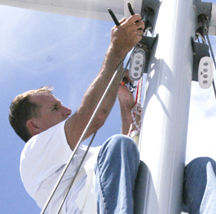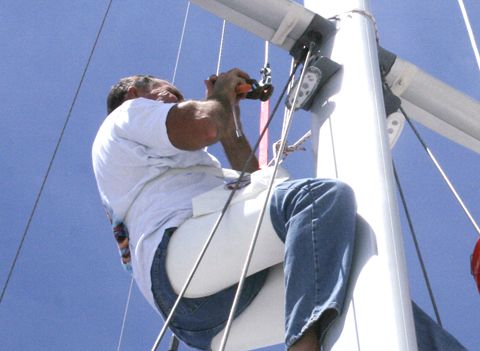With the fall and winter sailing season fast approaching in South Florida, it’s time for me buckle up and do a full inspection of the rig and spars on my Yankee 30, Opal. I know for certain there are two items that will need addressing. A spreader light, whisked away by Hurricane Ian last year, will need replacing. And the windex, which has seen one too many bird landings, will need adjusting, if not replacement.
The bosun’s chair we will use for the project is one that was overlooked in our last bosun’s chair test. Made by the pioneering Connecticut-based sailmaker Hathaway, Reiser, and Raymond (now defunct), the chair is constructed of heavily reinforced Dacron that can be adjusted to fit snugly around the thighs. A thick, adjustable webbing strap supports the back, and a safety tether and heavy-duty snap-hook is stitched onto the lifting ring. Velcro pockets on either side hold tools.
As we noted in our special report on climbing harnesses (“Simple Tricks When You’re Going Aloft“), these harness-type chairs are more comfortable than the conventional swing-type seats, making them a good choice for riggers or anyone who spends more than a few sweaty moments high off the deck. They also bring you closer to the top of the mast … and cost a fair bit more money.
One of our favorites from a not-so-long-ago test was a modified tree-climbers harness called the “Cruiser’s Harness,” designed by the late, great rigger Brion Toss. The chair retails for a hefty $480, but it will be the last one you’ll ever need. For sailors working with a tighter budget, the report “Simple Tricks When You’re Going Aloft” shows how a less-expensive climbing harness can be modified to provide similar comfort and support.

In another report, looked at other ways to get aloft, assisted and unassisted, using conventional bosun chairs or modified climbing ascenders, similar to the one popularly marketed as the ATN Mastclimber. We’ve also taken a deep dive into the gear that arborists use to hoist themselves aloft for pruning.
A good investment for anyone who plans to go aloft is Toss’s excellent DVD “Going Aloft.” on the topic. One of many great resources available at his website, the one-hour video covers the essential skills and procedures forgoing aloft safely.
Here are few of tips Toss shares:
Harnesses: Although not as comfortable as traditional chairs, harnesses bring you closer to the top of the mast and are more secure. Wear long pants and good shoes.
Halyards: Use two halyards-one primary, one safety. One should be an external halyard on a ratchet block leading from your harness back to you, so that you can have control over your own safety and ascent/descent.
Shackles and winches: Don’t rely on snap shackles or self-tailing jaws on winches. To attach the halyard to the harness, use locking screw-pin shackles or a buntline knot, which brings you closer to the masthead sheave than a bowline.
Tools: Always take vice grips and a non-folding rigging knife aloft. Toss also recommends taking a crescent wrench welded to a marlin spike, a versatile rigger’s multi-tool. Attach lanyards to all tools.
Preventing motion at sea: To reduce swinging, Toss suggests using a carabiner to secure your harness to a jackline halyard run tightly from the masthead to deck. We’ve also had good luck with sewn-loop prusiks, circular “slings” made of 3/8″ double-braid rope. Long enough to circle the mast twice with about 8-12 inches to spare, a prusik loop hitched around the mast (in a prusik hitch) will not only stop you from swinging, it will support you without slipping should the hoisting halyard fail.
Mast steps: Steps are a good idea at the mast bottom, for handling the main, and at the top of the mast, for relieving weight on the harness or chair while working at the masthead.





































My fractional rigged boat has only one halyard which goes to the top. How, other than using that halyard on its own, would one ever get a second halyard to the top, even if once there I could find something to fix it to?
Some Frac rigs have an integral Topping lift sheeve that is equal in strength to the main halyard sheave. In that case you can reeve a line equivalent to your halyard as the topping lift. This not only gives you the safety for going aloft but also provides a back up main halyard.
I have also have been able to attach a substantial block to the mast head crane that supports the backstay. Your mast head configuration will dictate. You can work with a rigger to determine what is safe. I would not go for an external mounted block unless there was access to through bolt it. That may require the rig being down.
Found this on PS Blog
:A more common application is to protect the climbing above the hounds on a 3/4 or 7/8 rig. Just climb the mast in the normal manner. When you reach the top of your safety line, wrap a prusik sling twice around the mast above the hounds, clip that to your harness and then unclip from the former safety line. Alternatively, you can just slack off the original safety line, leaving it in place as back-up and for the descent. Continue climbing, sliding the prusik up with each step. To descend, reverse the process.
https://www.practical-sailor.com/safety-seamanship/going-aloft-with-the-multi-use-prusik
I used a Bosun’s chair once on a 10 meter. It took me longer to find a deck ape to hoist me up than it did to change the anchor light. Since then I have purchased a Mast Mate and haven’t had to worry about needing help to get up the mast unassisted. It’s simple to hoist. Hook to the main halyard, put the sail lugs in the sail track as you raise it to your work area and secure the lower step to the deck. Climb it as a flexible ladder. No concern about swinging with the strap from the harness around the mast. It has a tool pouch large enough for a portable drill. I can reach the ends of the spreaders to inspect or repair. You can use your topping lift as a backup safety line. You do have to disconnect and reconnect the safety strap for the spreaders and shrouds as you ascend.